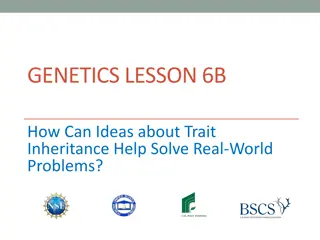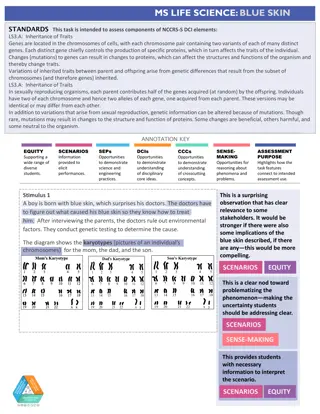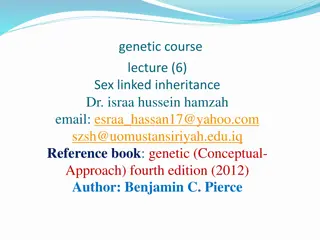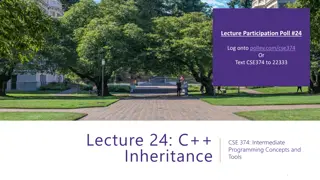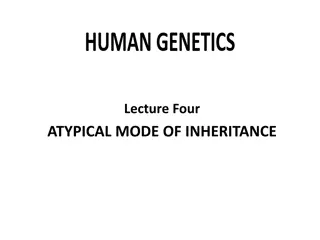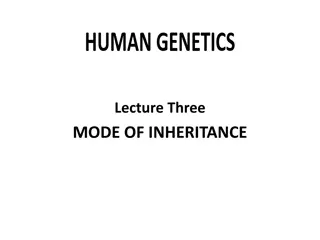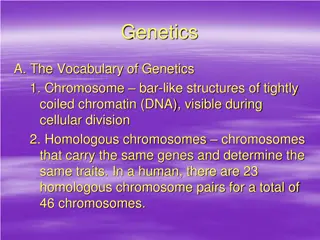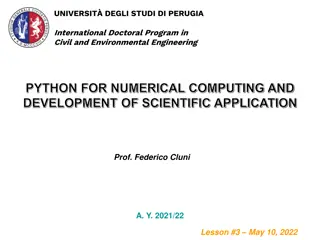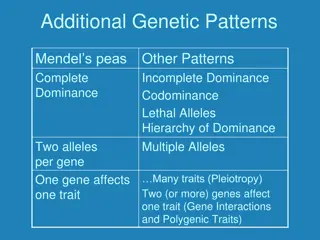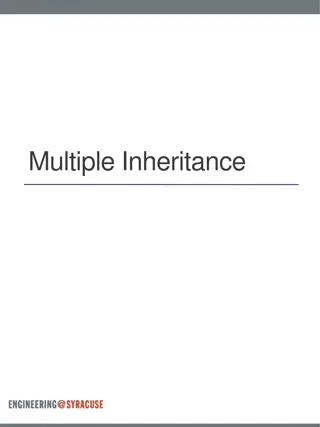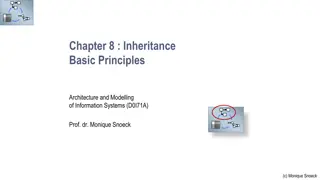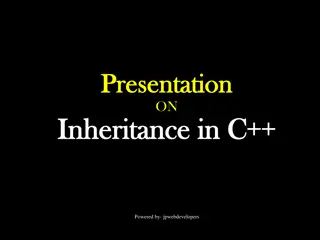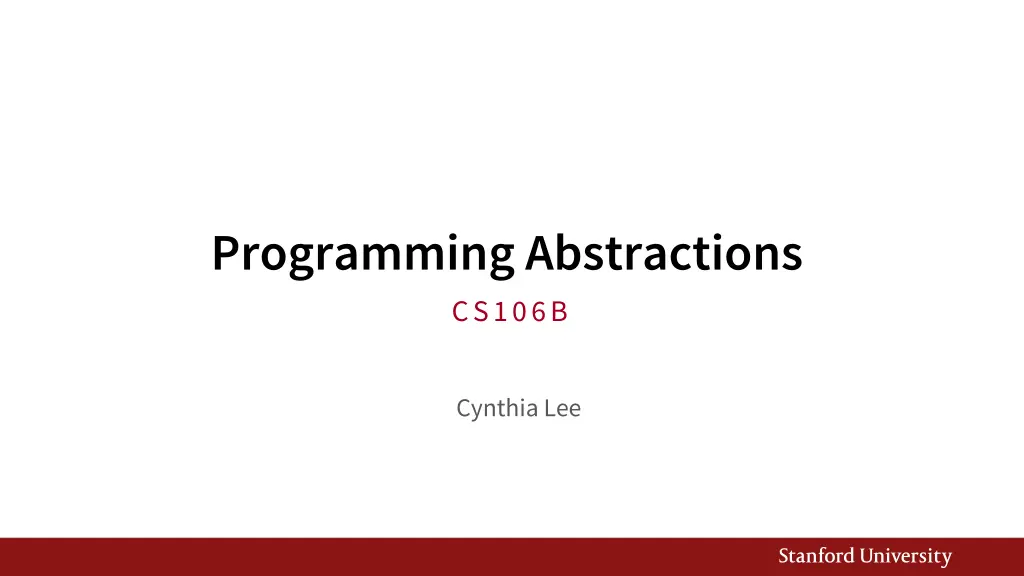
Understanding Inheritance in Programming: Basics and Examples
Explore the concepts of inheritance in programming, including what it is, why it is important, and how it is implemented. Learn about superclass, subclass, and practical examples from Stanford Library's G-Object family of classes. Discover the advantages of smart code reuse and organization through inheritance.
Download Presentation

Please find below an Image/Link to download the presentation.
The content on the website is provided AS IS for your information and personal use only. It may not be sold, licensed, or shared on other websites without obtaining consent from the author. If you encounter any issues during the download, it is possible that the publisher has removed the file from their server.
You are allowed to download the files provided on this website for personal or commercial use, subject to the condition that they are used lawfully. All files are the property of their respective owners.
The content on the website is provided AS IS for your information and personal use only. It may not be sold, licensed, or shared on other websites without obtaining consent from the author.
E N D
Presentation Transcript
Programming Abstractions CS106B Cynthia Lee
Inheritance Topics Inheritance The basics Example: Stanford GObject class Polymorphism
Inheritance What? Why? How?
Inheritance: what? is-a relationship: A hierarchical connection where one category can be treated as a specialized version of another. every rectangle is ashape every lion is ananimal type hierarchy: A set of data types connected by is-a relationships that can share common code. Re-use!
Inheritance: why? Remember the #1 rule of computer scientists: Computer scientists are super lazy in a good way! We want to reuse code and work as much as possible You ve already seen this going back to the very start of your CS education: Loops and Functions (instead of copy&paste to repeat code) Arrays (instead of copy&paste to make 100 named variables) Data structures(same idea as arrays but more expressive) Inheritance is another way of organizing smart reuse of code 5
Inheritance: how? inheritance: A way to form new classes based on existing classes, taking on their attributes/behavior. a way to group related classes a way to share code between two or more classes One class can extend another, absorbing its data/behavior.
Inheritance vocab superclass (base class): Parent class that is being extended. subclass (derived class): Child class that inherits from the superclass. Subclass gets a copy of every field and method from superclass. Subclass can add its own behavior, and/or change inherited behavior.
Inheritance Example Stanford Library G-Object family of classes Gob-ject
Behind the scenes We ve always told you not to worry about the graphics parts of your assignments. Just call this BoggleGUI function Now you can go ahead and take a look! 9
GObject hierarchy The Stanford C++ library contains a hierarchy of graphical objects based on a common base class named GObject. GArc GImage GLabel GLine GOval GPolygon GRect G3DRect GRoundRect hi
GObject members GObject defines the state and behavior common to all shapes: contains(x, y) get/setColor() getHeight(), getWidth() get/setLocation(), get/setX(), get/setY() move(dx, dy) setVisible(visible) double x; double y; double lineWidth; std::string color; bool visible; The subclasses add state and behavior unique to them: Glabel GLine get/setFont get/setStartPoint get/setLabel get/setEndPoint ... ... GPolygon addEdge addVertex get/setFillColor ... GOval getSize get/setFillColor ...
GObject members GObject defines the state and behavior common to all shapes: contains(x, y) get/setColor() getHeight(), getWidth() get/setLocation(), get/setX(), get/setY() move(dx, dy) setVisible(visible) double x; double y; double lineWidth; std::string color; bool visible; The subclasses add state and behavior unique to them: Glabel GLine get/setFont get/setStartPoint get/setLabel get/setEndPoint ... ... GPolygon addEdge addVertex get/setFillColor ... GOval getSize get/setFillColor ...
GObject hierarchy Q: Rectangle is-a Polygon, right? Why doesn t it inherit from Polygon?? The Stanford C++ library contains a hierarchy of graphical objects based on a common base class named GObject. GArc GImage GLabel GLine GOval GPolygon GRect G3DRect GRoundRect Although true in geometry, they don t share many fields and methods in this case. hi
Inheritance Example Your turn: let s write an Employee family of classes
Example: Employees Imagine a company with the following employee regulations: All employees work 40 hours / week Employees make $40,000 per year plus $500 for each year worked Except for lawyers who get twice the usual pay, and programmers who get the same $40k base but $2000 for each year worked Employees have 2 weeks of paid vacation days per year Except for programmers who get an extra week Each type of employee has some unique behavior: Lawyers know how to sue Programmers know how to write code
16 Employee class // Employee.cpp Employee::Employee(string name, int years) { m_name = name; m_years = years; } // Employee.h class Employee { public: Employee(string name, int years); virtual int hours(); virtual string name(); virtual double salary(); virtual int vacationDays(); virtual int years(); int Employee::hours() { return 40; } string Employee::name() { return m_name; } double Employee::salary() { return 40000.0 + (500 * m_years); } int Employee::vacationDays() { return 10; } private: string m_name; int m_years; }; int Employee::years() { return m_years; }
Exercise: Employees Exercise: Implement classes Lawyer and Programmer. A Lawyer remembers what law school he/she went to. Lawyers make twice as much salary as normal employees. Lawyers know how to sue people (unique behavior). Lawyers put , Esq. at the end of their name. Programmers make the same base salary as normal employees, but they earn a bonus of $2k/year instead of $500/year. Programmers know how to write code (unique behavior).
Inheritance syntax class Name : public SuperclassName { Example: class Lawyer : public Employee { ... }; By extending Employee, each Lawyer object now: receives a hours, name, salary, vacationDays, and years method automatically can be treated as an Employee by client code
Call superclass c'tor SubclassName::SubclassName(params) : SuperclassName(params) { statements; } To call a superclass constructor from subclass constructor, use an initialization list, with a colon after the constructor declaration. Example: : Employee(name, years) { // calls Employee constructor first m_lawSchool = lawSchool; } Lawyer::Lawyer(string name, string lawSchool, int years)
// Employee.h class Employee { public: Employee(string name, int years); int hours(); string name(); double salary(); int vacationDays(); string vacationForm(); int years(); Your turn: inheritance string Lawyer::name() { ??? } For adding , Esq. to the name, which of the following could work? private: string m_name; int m_years; }; A. return m_name + ", Esq."; B. return name() + ", Esq."; C. return Employee::name() + ", Esq."; D. None of the above E. More than one of the above
Call superclass member SuperclassName::memberName(params) To call a superclass overridden member from subclass member. Example: double Lawyer::salary() { // paid twice as much return Employee::salary() * 2; } Note: Subclass cannot access private members of the superclass. Note: You only need to use this syntax when the superclass's member has been overridden. If you just want to call one member from another, even if that member came from the superclass, you don't need to write Superclass:: .
Polymorphism Start with how
Polymorphism polymorphism: Ability for the same code to be used with different types of objects and behave differently with each. Templates provide a kind of compile-time polymorphism. Grid<int> or Grid<string> will output different things for myGrid[0][0], but we can predict at compile time which it will do Inheritance provides run-time polymorphism. someEmployee.salary() will behave differently at runtime depending on what type of employee may not be able to predict at compile time which it is
Polymorphism A pointer of type T can point to any subclass of T. Employee Employee *diane = new Lawyer("Diane", "Stanford", 5); Programmer*cynthia = new Programmer("Cynthia", 10); *neha = new Programmer("Neha", 2); Why would you do this? Handy if you want to have a function that works on any Employee, but takes advantage of custom behavior by specific employee type: void doMonthlyPaycheck(Employee *employee) { cout << "You are now $" << employee->salary()/12 << " wealthier!" << endl; }
Polymorphism A pointer of type T can point to any subclass of T. Employee *neha = new Programmer("Neha", 2); Employee *diane = new Lawyer("Diane", "Stanford", 5); Programmer*cynthia = new Programmer("Cynthia", 10); When a member function is called on diane, it behaves as a Lawyer. diane->salary(); (This is because all the employee functions are declared virtual.) You can not call any Lawyer-only members on diane (e.g. sue). diane->sue(); // will NOT compile! You can call any Programmer-only members on cynthia (e.g. code). cynthia->code("Java"); // ok!
Polymorphism examples You can use the object's extra functionality by casting. Employee *diane = new Lawyer("Diane", "Stanford", 5); diane->vacationDays(); // ok diane->sue("Cynthia"); ((Lawyer*) diane)->sue("Cynthia"); // ok // compiler error Pro Tip: you should not cast a pointer into something that it is not! It will compile, but the code will crash (or behave unpredictably) when you try to run it. Employee carlos->code(); // compiler error ((Programmer*) carlos)->code("C++"); // ok ((Lawyer*) carlos)->sue("Cynthia"); // No!!! Compiles but crash!! *carlos = new Programmer("Carlos", 3);
Rules for virtual: runtime calls DerivedType * obj = new DerivedType(); If we call a method like this: obj->method(), only one thing could happen: 1. DerivedType s implementation of method is called BaseType * obj = new DerivedType(); If we call a method like this: obj->method(), two different things could happen: 1. If method is not virtual, then BaseType s implementation of method is called 2. If method is virtual, then DerivedType s implementation of method is called
Rules for virtual: pure virtual If a method of a class looks like this: virtual returntype method() = 0; then this method is a called pure virtual function and the class is called an abstract class Abstract classes are like Java interfaces You cannot do = new Foo(); if Foo is abstract (just like Java interfaces) ALSO, you cannot do = new DerivedFoo(); if DerivedFoo extends Foo and DerivedFoo does not implement all the pure virtual methods of Foo
class Mammal { public: virtual void makeSound() = 0; string toString() { return Mammal ; } }; class Cat : public Mammal { public: virtual void makeSound() { cout << rawr << endl; } string toString() { return Cat ; } }; class Siamese : public Cat { public: virtual void makeSound() { cout << meow << endl; } string toString() { return Siamese ; } virtual void scratchCouch() { cout << scraaaatch << endl; } }; (A) Mammal (B) Cat (C) Siamese (D) Gives an error (identify compiler or crash) (E) Other/none/more What is printed? Siamese * s = new Mammal; cout << s->toString();
class Mammal { public: virtual void makeSound() = 0; string toString() { return Mammal ; } }; class Cat : public Mammal { public: virtual void makeSound() { cout << rawr << endl; } string toString() { return Cat ; } }; class Siamese : public Cat { public: virtual void makeSound() { cout << meow << endl; } string toString() { return Siamese ; } virtual void scratchCouch() { cout << scraaaatch << endl; } }; (A) Mammal (B) Cat (C) Siamese (D) Gives an error (identify compiler or crash) (E) Other/none/more What is printed? Siamese * s = new Siamese; cout << s->toString();
class Mammal { public: virtual void makeSound() = 0; string toString() { return Mammal ; } }; class Cat : public Mammal { public: virtual void makeSound() { cout << rawr << endl; } string toString() { return Cat ; } }; class Siamese : public Cat { public: virtual void makeSound() { cout << meow << endl; } string toString() { return Siamese ; } virtual void scratchCouch() { cout << scraaaatch << endl; } }; (A) Mammal (B) Cat (C) Siamese (D) Gives an error (identify compiler or crash) (E) Other/none/more What is printed? Mammal * m = new Mammal; cout << m->toString();
class Mammal { public: virtual void makeSound() = 0; string toString() { return Mammal ; } }; class Cat : public Mammal { public: virtual void makeSound() { cout << rawr << endl; } string toString() { return Cat ; } }; class Siamese : public Cat { public: virtual void makeSound() { cout << meow << endl; } string toString() { return Siamese ; } virtual void scratchCouch() { cout << scraaaatch << endl; } }; (A) Mammal (B) Cat (C) Siamese (D) Gives an error (identify compiler or crash) (E) Other/none/more What is printed? Mammal * m = new Siamese; cout << m->toString();
class Mammal { public: virtual void makeSound() = 0; string toString() { return Mammal ; } }; class Cat : public Mammal { public: virtual void makeSound() { cout << rawr << endl; } string toString() { return Cat ; } }; class Siamese : public Cat { public: virtual void makeSound() { cout << meow << endl; } string toString() { return Siamese ; } virtual void scratchCouch() { cout << scraaaatch << endl; } }; (A) Mammal (B) Cat (C) Siamese (D) Gives an error (identify compiler or crash) (E) Other/none/more What is printed? Mammal * m = new Siamese; m->scratchCouch();
class Mammal { public: virtual void makeSound() = 0; string toString() { return Mammal ; } }; class Cat : public Mammal { public: virtual void makeSound() { cout << rawr << endl; } string toString() { return Cat ; } }; class Siamese : public Cat { public: virtual void makeSound() { cout << meow << endl; } string toString() { return Siamese ; } virtual void scratchCouch() { cout << scraaaatch << endl; } }; What is printed? Cat * c = new Siamese; c->makeSound(); (A) rawr (B) meow (C) Siamese (D) Gives an error (identify compiler or crash) (E) Other/none/more


